Call us FREE 0808 2394 989
Opening Hours - Office closed, we'll open at 8:30am
Call us FREE 0808 2394 989
Opening Hours - Office closed, we'll open at 8:30am

If you’re a ‘tombstone tourist,’ you’ll be dying to visit some of the world-famous places of rest
Published on 13 Sep 2019
Since as far back as time can tell, society has honoured their dead by laying loved ones to rest. A natural part of life, it’s intriguing for the living to see how different cultures pay homage to their dead. So much so, in fact, many of the world’s most famous cemeteries receive millions of visitors every year. And who can blame them? One of the reasons we travel around the world is to experience how other cultures live, so it seems only natural to want to explore what happens when they die. If you consider yourself to be a ‘tombstone tourist,’ we’ve put together a list of some of the most fascinating cemeteries in the world for you to visit while you’re still alive and kicking.
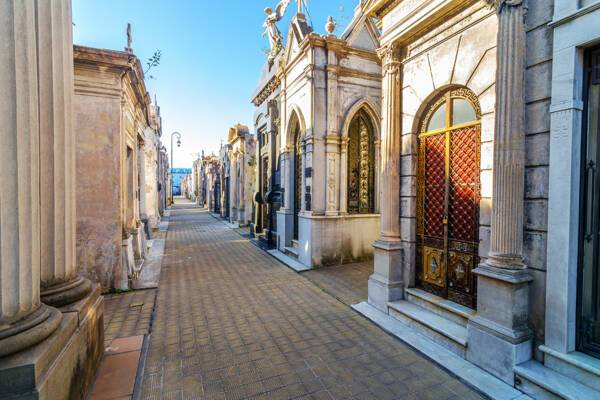
Recoleta Cemetary (Cementerio de la Recoleta) in Buenos Aires, Argentina, is the resting place for some of the noblest and wealthiest families to have ever walked the city’s streets. Inside, you’ll see a patchwork of shoulder-to-shoulder mausoleums and tombs, each as unique as the last. Ornamented with opulent statues and domes, weaving between these marble masterpieces will certainly evoke the dark tourist in you.
Erin from Sol Salute explains why visiting Recoleta Cemetary is a must when in Buenos Aires: “The Recoleta Cemetery is like a city within a city. Inside its walls are streets and alleyways guiding you through the countless mausoleums and crypts. It is unlike any cemetery you’ve ever seen before, so it’s no surprise that it’s one of the most popular sites in Buenos Aires. Past presidents, generals, Nobel Prize winners and even the venerable Evita are all interred here. It’s free to visit and while you don’t need a guide to visit, it wouldn’t be a bad idea to consider hiring an expert to show you the historical graces and explain the many legends and ghost stories that surround this place.
“I find the contrast of the decadent and the decay particularly fascinating. Despite being in the wealthiest area of the city and housing the city’s greatest figures, many of the graces are in a serious state of decay. Each mausoleum is private property, so if the family has died out or is simply apathetic, there is no one to maintain it. You’ll notice many seem to be crumbling down while others seem polished and pristine.”
Ryan from Desk to Dirtbag told us what makes Recoleta Cemetery so impressive, “Rather than a drab, macabre place, a visit to Recoleta Cemetery is more akin to walking through an open-air art museum, filled with statues, sculptures, architecture and history. While I haven’t visited tons of cemeteries, the Recoleta Cemetery certainly stands out as the most impressive I’ve ever seen in my travels and there’s a good reason why it’s one of the top things to do in Buenos Aires. The cemetery is open daily until 6 pm and entry is free. You’ll also find regularly scheduled free tours of the cemetery in both English and Spanish to help bring the history to life.”
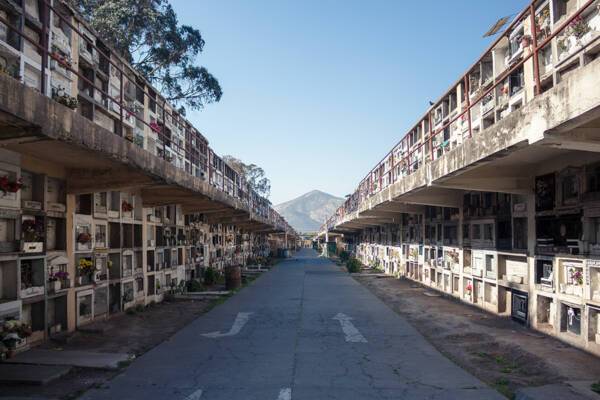
One of the largest cemeteries in Latin America, Cementario General in Santiago, Chile, is the final resting place of over 2 million people. First built in the 19th century, this city-sized cemetery is not like traditional graveyards with plots and headstones. Instead, the dead are buried in row upon row of graces, creating mosaic-like walls of tiled memorial stones.
Filip from Travel Like A Game told us a bit more about the cemetery’s layout and incredible history, “Cementerio General is like a small city with its own structure of streets, passages, squares and monuments. The cemetery is divided into two sectors, one historical and another general. The historical side is the closest to the main entrance, which is like an outdoor museum that introduces you to part of the history of Chile. Here lie important figures like former presidents, artists, writers and other influential figures. Highlights include the Monument to Bernardo O’Higgins, the tomb of Andrés Bello, the tomb of Salvador Allende and the Memorial of the Missing Prisoners.
“The other sector located on the northern side of the cemetery is where the rest of the people remain, which has a more dismal character and can be frightening sometimes. Here lies one of the most impacting spots in the cemetery, Patio 29, which was declared a historical monument in 2006. It was used clandestinely as a common grave to bury the bodies of executed political prisoners in the military dictatorship of Augusto Pinochet.
Alison from Dreamer at Heart told us what makes the cemetery so captivating, “The Cementario General de Santiago is one of those intriguing cemeteries where you could wander indefinitely. Stroll along leafy boulevards where purple bougainvillaea drapes itself over mausoleums dedicated to dignified families. Elaborate graves, one even created to emulate the Alhambra in Spain, draw attention and beg the question, ‘Who were you?’”
“With the Andes Mountains as a backdrop, row upon row of stacked graves, five stories high, stretch as far as the eye can see. The plots, which are reminiscent of cupboard doors, hold stories that can only be imagined from the trinkets and flowers laid before them. Some of the doors are dislodged from not-so-recent earthquakes but family members have yet to come and lovingly restore them. A visit to the Cementario General de Santiago offers a quiet respite to the bustling city and an insightful perspective into the history of the Chilean people.”
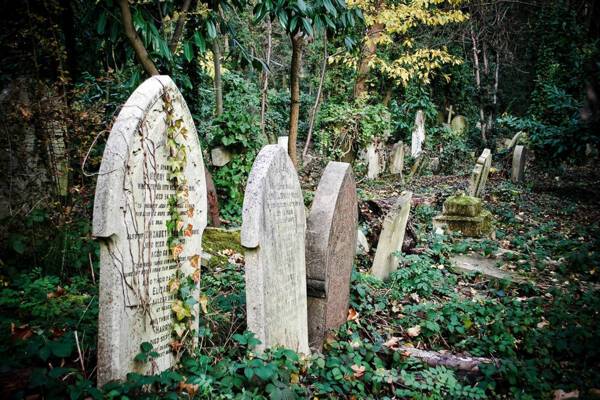
Highgate Cemetery is England’s most famous cemetery. With an abundance of unruly, overgrown plants and rain-weathered gravestones, Highgate Cemetery is highly regarded not only for some of the notable figures buried there but also for its Grade I listed status on the Register of Historic Parks and Gardens.
Steve from The Trip Goes On once worked at the cemetery, he told us about its famous occupants, “Highgate Cemetery is best known as the final resting place of German philosopher Karl Marx, however, there is so much more to this enchanting Victorian graveyard than the author of Das Kapital.
“The cemetery is located across two distinct sites on the east and west sides of Swain’s Lane. The east cemetery is home to Marx, punk legend and Sex Pistols manager Malcolm McLaren and writer George Elliot, among many others. A ticket to the east cemetery allows you to wander at your leisure amongst crumbling gravestones, but it is the western cemetery that should be a must for any visit to London.
“You can only enter the western cemetery on a guided tour, but the ornate gravestones, gothic crypts and large mausoleums are a truly impressive site with fantastic architecture. The west side is a little overgrown and very quiet, making it a perfect escape from the hustle of the city. Keep your eyes peeled for the lead-lined coffin of the Russian spy, Alexander Litvinenko, the Egyptian Avenue and the Terrace Catacombs. As dark tourism is all the rage these days, what better place to explore the spooky history of old London?”
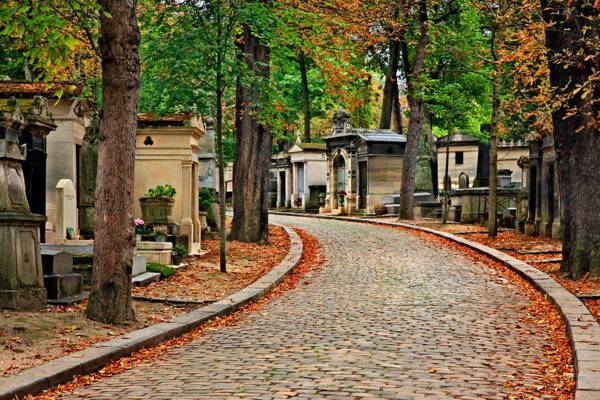
One of the most famous cemeteries in the world is the Cimetière du Père Lachaise (Cemetery of the East) in Paris, France. Over 110 acres in size and welcoming over 3.5 million visitors per year, the Père Lachaise Cemetery holds the title of the most visited necropolis in the world. No two mausoleums, tombstones and graveyards are alike in this cemetery, and it all makes for a stunning architectural display while you walk down the cobbled paths.
Patricia from Ze Wandering Frogs told us why the cemetery is such a popular tourist spot, “No cemetery is more iconic in Paris than the Cimetière du Père Lachaise. And no visit to the French capital is complete without a visit to the famous graveyard. Why, you may ask, is this Parisian cemetery so unique? Probably because so many celebrities are buried there.
“Right from its opening, the Père Lachaise has been associated with legendary names. Indeed, the cemetery opened under Napoleon Bonaparte in 1804 and is named after François d'Aix de La Chaise, whose nickname was Père Lachaise (Father Lachaise). That Father was the confessor to Louis XIV, the Sun King that made the Palace of Versailles the stunning monument that we know today.
“Among the 70,000 tombs present, numerous personalities have made the Père Lachaise their permanent home. Artists, singers and musicians include Frédéric Chopin, Rossini, Jim Morrison, Edith Piaf and Alain Bashung. Novelists and writers such as Molière, Balzac, Colette, Marcel Proust, Jean de la Fontaine and Oscar Wilde, all lay side-by-side along with various politicians like Èdouard Daladier and Président Félix Faure.”
Patricia also provided details on the unique mausoleums and headstones that line the cemetery’s paths, “Several tombs and mausoleums originate from the 19th century and display intricate designs and architecture. Old and large trees line the many cobblestoned alleys, framing and isolating the graves, providing a sense of peace and quiet as required for such a solemn context. With such a wide-spread area to explore, it’s easy to spend several hours wandering the small lanes, stopping to read the names on the headstones, pondering what their lives must have been and feeling the grandeur of their fame. Each section of the cemetery has its charms, though the narrower the alley, the more intimate the experience.”
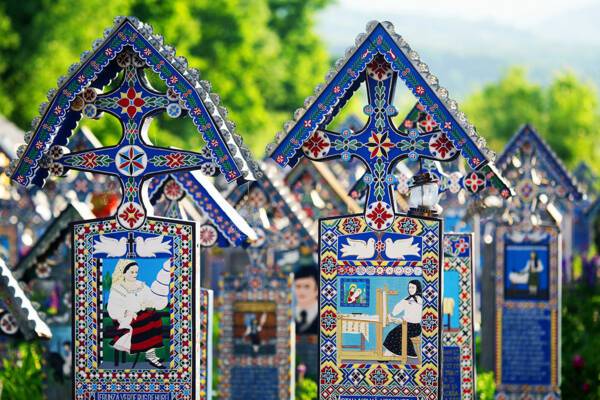
The Merry Cemetery in Romania is exactly what it sounds like - merry. The most colourful cemetery in the world, Merry Cemetery is full of charming headstones adorned in bright colours, poetry and paintings, which often depict fun anecdotes of the departed. When visiting, it’s highly recommended you take a guide with you that can translate some of the poems, so you can get in on the jokes too.
Carly from Fearless Female Travels told us what sets Merry Cemetery apart from other places of rest, “Unlike most cemeteries, which are sombre places of remembrance, Merry Cemetery is full of joy. It is home to more than 700 brightly painted wooden tombstones, each depicting a comical image of the deceased’s life or death, and a playful poem celebrating the same.
“All 700 tombstones were painted by just two men: first, Stan Ioan Patras, then after his death in 1977, Dumitru Pop, his apprentice. It’s a wonderful place to visit for anyone interested in folk art or quirky, off-the-beaten-path destinations. Although the Merry Cemetery has gained popularity in recent years from being featured on Anthony Bourdain’s television program about Romania, it still remains relatively obscure and visitors are guaranteed an authentic, small-town Romanian experience.”
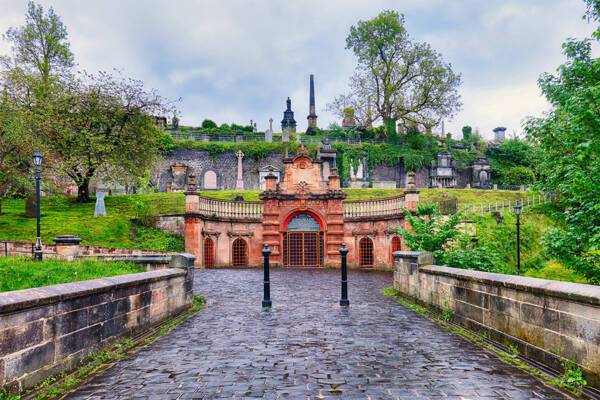
The Glasgow Necropolis is a beautiful, Victorian cemetery that looks like something from the pages of a gothic novel. This majestic cemetery houses roughly 50,000 graces, all of which sit still below Glasgow Cathedral, which towers above the necropolis in the distance.
Nikolina from P.S. Don’t Read this told us about the infamous Glasgow Necropolis cemetery and what makes it so incredible, “Glasgow Necropolis is a Victorian cemetery which was modelled on Cimetière du Père Lachaise in Paris. It is located on a hill behind Glasgow Cathedral on Castle Street. A bridge called the Bridge of Sighs leads to the entry of the necropolis.
“There are different monuments erected here in Classical Revival style which gives the necropolis its unique look. Among them, you can find a Celtic cross made by Charles Rennie Mackintosh, a monument to John Knox and a memorial to the author of Wee Willie Winkie. But don’t be mistaken to think that only famous people are buried here. There are 50,000 graves for people from different classes and religions including Jewish people, Catholics, Protestants and Lutherans.
“Standing on the hill, you will get magnificent views of Glasgow Cathedral on one side and a view of the city on the other. Today, the necropolis is a favourite spot for photographers and tourists. Most of them are trying to find Mackintosh’s Celtic cross but if you are like me, a fan of Dan Brown and the Da Vinci Code, you can search for the numerous Freemason symbols.”

If you find yourself in Virginia, USA, it’s worth taking a trip to Arlington to visit the city’s military cemetery. The Arlington National Cemetery was established during the Civil War in 1864 and stretches across 624 acres. What makes this cemetery so hauntingly powerful is the reaching views of the small, pearly-white gravestones, marking the hundreds of thousands of soldiers who died fighting for their country.
Sage from Everyday Wanderer told us about the history of the cemetery and how it became the eminent resting place it is today, “Arlington National Cemetery is the final resting place of more than 400,000 people, including President John F. Kennedy and several members of his family. But one of the most interesting things about Arlington National Cemetery is how it came to be.
“High on a hill just above John F. Kennedy’s grave stands a commanding building that looks like a Greek temple. Arlington House, the former mansion of General Robert E. Lee, has a fascinating history. Built by slaves at the direction of George Washington’s grandson, the property was confiscated when Robert E. Lee left the Union Army during the Civil War.
“As the death toll in America’s bloodiest war continued to rise, military leaders were determined to get revenge on General Lee. They converted 200 acres of his beautiful estate into a cemetery, and the first Union Army soldiers were laid to rest in the main flower garden close to the house to ensure that Lee and his family would never want to return. When visiting Arlington National Cemetery today, don’t miss a chance to also explore Arlington House, now the Robert E. Lee Memorial.”
We also chatted with Sharon from Exploring Our World, she told us why a visit to Arlington Cemetery is so special, “Arlington National Cemetery is the United States’ sacred resting place for those who have served their country. Arlington’s rolling hills rise above the Potomac River, with a view across to the monuments of the nation’s capital. Arlington was first used as a burial place in 1864 during the Civil War. Today, more than 400,000 honoured dead are in Arlington. Notables include President John F. Kennedy, whose grave is marked with an eternal flame.
“A highlight of a visit to Arlington is the Changing of the Guard at the Tomb of the Unknown Soldier. The symbolic grace has been guarded 24 hours a day, 7 days a week without a break since 1930. The respectful ceremony takes place every half hour from April to September and once an hour in the remaining months. When you walk the grounds at Arlington, you walk in the presence of heroes.”